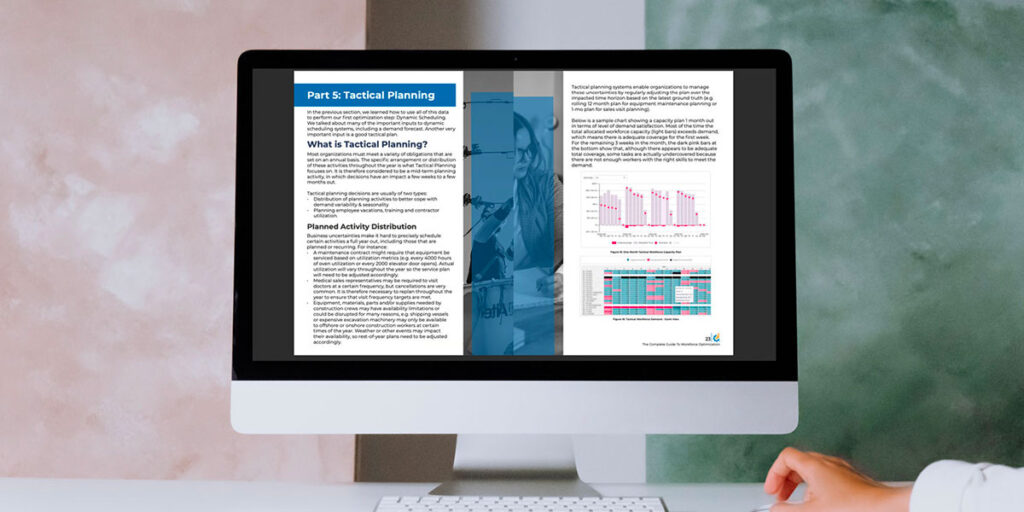Blog
Part 2: Benchmarking Performance Metrics - The Complete Guide To Workforce Optimization
In our last post, The Complete Guide To Workforce Optimization Part 1: Skills Catalog, we discussed the importance of creating an employee skills and work catalog (parts of the taxonomy). This enables software systems to help identify capacity-demand mismatches, or understaffing and overstaffing, in planning and scheduling applications. What wasn’t discussed is how to match the right quantity of capacity, in terms of person-hours or person-days, to fulfill a given amount of demand.
In services industries, accurate and granular benchmarking metrics enable bidders to set the right price so that the project is priced competitively but can still be profitable.
What is Meant by Performance Benchmarking?
Performance benchmarking is about quantifying the normal expected amount of manpower to satisfy a given type and unit of demand. For the purpose of planning and scheduling, we are not factoring in a work quality metric but assume that all workers have similar productivity for a given task. In other words, we are setting the expectation for how many desks, hospital beds or square feet of space can be cleaned per hour.
Who Needs to do Performance Benchmarking?
Performance benchmarking is usually needed in industries with workforces that perform regular and repeatable activities, such as cleaning and sanitation, security, catering and facility management.
Benchmarking is not usually required for organizations whose employees are performing complex or unpredictable reactive support and repair services, such as automotive or appliance repair or emergency medical technicians. In the case of technicians performing routine planned or preventive maintenance, service times for these activities are usually known. Contact center performance metrics are also fairly well-known by service providers.
Any organization that doesn’t feel they have task-level performance data may need to perform benchmarking before implementing an optimization system. This performance benchmark data will later be joined to the taxonomy discussed in the last article Part 6: Strategic Planning.
What is the Right Level of Granularity & Measurement Unit?
Benchmarking can be done at different levels of granularity, from the single activity level (ex. cleaning windows) to the service type level (ex. interior cleaning). The level of granularity may require some thought. If the granularity level is too fine, then the data collection and integration effort will be higher. For instance, you may not need to detail out the time it takes for a senior housekeeper vs a junior housekeeper to clean a room.
Too coarse a granularity, on the other hand, will result in plans and schedules that are less optimal, meaning frequently overstaffed or understaffed. This could happen, for instance, if you don’t account for the extra time it takes to clean a multi-room suite.
The units of measurement can also vary by work type. Some examples are the time it takes hospital staff to perform various medical procedures may reside in a lookup chart of minutes per procedure. Cleaning staff may be benchmarked based on the number of square feet, hospital beds, rooms, or windows serviced in the case of window cleaning. It’s a good idea to involve front-line managers to determine which are the best metrics to use.
How to Derive Performance Metrics
There are different approaches to measuring performance. The traditional way is to observe the worker. The problem with this approach is that a worker may feel pressured to work at higher-than-usual efficiency, so the numbers may not scale well.
A good practice is to perform benchmarking passively through analytical approaches. This could involve looking at historical staffing levels alongside, say, patients served, hotel occupancy rates, commercial office square footage, or the number of desks cleaned. From there, performance averages can be derived based on the number of hours worked per person, per unit (ex by room, desk, or square feet).
Communication is key
Benchmarking employees can be a sensitive topic, especially for unionized workers. That’s why it’s critical that leadership effectively communicate why and how the information will be used.
Some industries, like warehousing, often use benchmarking to drive greater productivity through competitive peer pressure. This is probably not ideal, for a services outsourcing company that needs to balance costs with service levels.
Whatever the reason for doing benchmarking, you should make it clear to your employees why you’re doing it and how it benefits them and the company.
Read all the articles of The Complete Guide to Workforce Optimization:
Introduction to our Series
Part 1 Cataloging Employee Skills and Work Activities
Part 3 Demand Planning
Part 4 Operational Scheduling
Part 5 Tactical Planning
Part 6 Strategic Planning
About the Author
Giulia Burchi is a Sr. Business Analyst with DecisionBrain. She brings extensive experience delivering advanced planning, scheduling, and workforce optimization solutions to organizations with large or distributed teams. She holds a master’s degree in Industrial Engineering from the University of Bologna in Italy.










